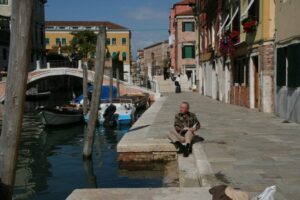Below are photos from Oil Painters of America’s Twenty-third Annual National Exhibition, which was held at The Bennington Center for the Arts in Bennington, Vermont.
To see all photos taken at the 2014 National Exhibition, click here.
Photo
Some Thoughts On Plein Air And Photos

Take Monet’s large water lily murals for example. There are photos showing these paintings being executed in his studio at Giverny. There are also photos in existence which he took of the water lily pond, and since the pond isn’t visible from the studio it’s likely that he used them as reference for the murals.
The American Impressionist, Theodore Robinson, left photos with grid marks on them which are used in transferring more accurately the photo to the canvas, and also left paintings which are almost exact replicas of the photos.
And in some of Corot’s later work figures appear which could only have been arrived at through the use of photographic reference. For instance, there is a horse and rider which appears in more than one of his later paintings. It is a small figure, but it is photographically accurate, even though the horse is in motion and could only have been in that pose for a fraction of a second. And we know both from his sketches and from his own admission that he could not capture such details in so limited a time working from the subject.
So, well-known artists have worked from different types of sources, but which is best?
Working directly from the subject out-of-doors is called “plein air”. It is good practice, especially for beginners, because it forces you to work rapidly under less than favorable conditions, and this brings your instincts into play and causes you to learn more rapidly and to paint more spontaneously. It has the disadvantage of lighting which is always changing, bugs in your paint and comments from curious passersby. Most artists who paint this way solve the first problem by taking a photo early on which they later use in the studio to make corrections and apply finishing touches.
If you do want to use photos, here are some pointers: Use only your own photos. Photography is an art form and the photos you take represent your personal knowledge concerning what makes a good picture. Never use published professional photos. These were not your ideas, and in some places there are laws against their use. Don’t slavishly copy the photo. All good artists develop their own ideas about color, composition, etc., which they impose on the subject.
Paint From Life or Photos?

There are a host of good reasons to use photos:
- They’re convenient
- The light doesn’t change
- You can blow up small details
- You can be comfortable
- There are no bugs, wind, interrupting strangers etc.
- The model doesn’t move or get tired
There’s only one really good reason to work from life – it will make us much better artists.
Over time, we representational artists become skilled at rendering what we see. The problem is that even high-quality digital photos lie to us. Think of the four elements of a realistic painting: shapes (drawing or proportion), values, color temperature relationships, and edges. Three of the four are always wrong in a photo… and sometimes it’s all four.
The two or three darkest values turn into black and the lightest values become white (photographers call it “blowing out” the lights). The color temperature relationships are limited by the dyes used to make the prints or the phosphors in our computer screens. Also, the camera sees edges as equally sharp (not at all like the human eye which focuses on a sharp area in the center of our visual field surrounded by fuzzy shapes on the periphery).

When I critique portfolios at various art events I often see paintings where the shadows are black, the lights are white, all the edges are hard, and the light and the darks are the same temperature. I ask the artist, “you work mostly from photos, don’t you?” I often get the astonished reply, “how did you know?”
The pros work primarily from life: For one, it’s much easier to develop good edge control. Also, our sensitivity to nuance of color and temperature improves exponentially. We just can’t see those nuances in photos… I know; I’ve tried! Working from life, we learn to see the elusive, sparkling color in half tones. Our shadows start to have a sense of light and air in them instead of being dense, opaque blobs.
So, if you’ve decided to go the extra mile, how do you break free of the photo? The still life is easy. Just set it up and start painting. Likewise, there’s little excuse for trying to paint a landscape from a photo. If you’re nervous about going out alone, find a painting buddy or group. There are Plein Air groups in most areas now. OPA sponsors paint outs all over the country. Seek, and ye shall find.

Once we start to see the benefits in our work, we want more. The little bit of extra effort to paint from life, pays off tenfold.
Happy painting!